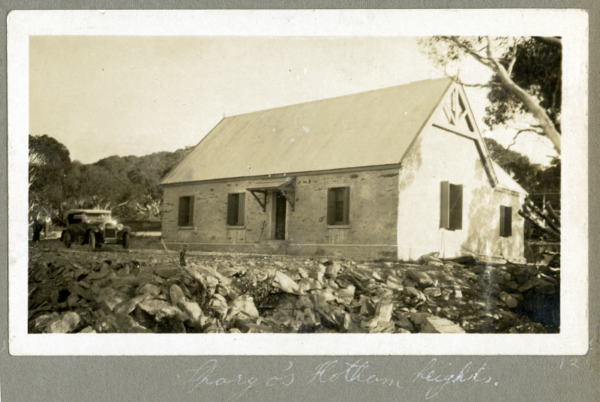

William Benjamin Spargo (b. 1888) made his home in one of the most inhospitable regions of Victoria. A pioneer of the fledging alpine sports, he lived through extreme poverty and amassed a fortune on the back of determination and ingenuity. As the first man to live on Mt. Hotham through the winter, he had a hand in many of the early structures in the region.
Spargo came to the Hotham region convinced there was gold to be found in the mountains; and to that end he took work with the Country Roads Board in 1921 to maintain the Mt. Hotham Road. The job allowed him to sustain himself whilst prospecting and the CRB built the Hotham Heights Chalet for him, the first of many of his high plains huts.
Through winter however, the snow would put both the road and the gold well out of Spargo’s reach. So Hotham Heights took on a secondary role; becoming a guest house for the burgeoning skiing community in Melbourne with Spargo, a self-taught skier, its host. This proved to be an attractive site for skiers, and lucrative for Spargo. In 1928 he resigned his duties with the Roads Board to focus entirely on skiing, partnering with Austrian ski instructor Helmut Kofler. The two clashed and soon separated, but the growth of Hotham’s skiing continued, and Spargo was asked the next year to oversee the construction of a second hut on the high plains, Cope Hut, for hikers and skiers.

Ill fortune struck again in 1939 as Black Friday tore through the high country leaving little in its wake. While others fled to safety, Spargo remained to protect his property, utilising every ounce of his ingenuity to save his home. He soaked everything he could with water to prevent the fires taking hold, going as far as to divert a creek through his hut. In spite of his determination, it was an incredibly risky decision to remain, something Spargo himself understood well, he kept a loaded shotgun with him should the worst come about. which very nearly did, when the fires reached him the heat was so intense it caused the roof of the hut to cave in, landing on Spargo, leaving him lucky to have survived.

In spite of the damage to the hut and himself, Spargo had succeeded, his hut was still more or less standing after the fires. The same could not be said for Hotham Heights, which had been abandoned and reduced to rubble by the blaze.
Spargo’s determination was rewarded the following year, close to twenty years after taking the job with the Country Roads Board, he struck gold at a place he named Red Robin Reef. His discovery was published in papers nation-wide, and offers came flooding in. A Sydney syndicate offered some £60,000 (around $6,000,000 in 2018) for the mining rights to the Red Robin Mine, but Spargo turned down all comers in favour of working the mine for himself.
His fame ballooned with this find, and he was inundated with letters, some from as far of as British Malaya (modern Malaysia).
Spargo worked the mine until 1953, when he was 65, when he finally felt too old for the work. He sold the mine along with the hut he had built there and left the freezing High Country for Queensland. He lived there for 6 years in retirement before his death, aged 74.
Further Reading
Bennet, D Hotham horizon : the Alpine Club of Victoria : reminiscence
High Country Heritage Research Centre, High Country Heritage Huts
Hueneke, K Huts in the Victorian Alps and the people who care for them
Garden, D Spargo, William Benjamin, Australian Dictionary of Biography, vol 16
Lawrence, R Huts of the Bogong High Plains
Magnussen, F Victoria’s alpine heritage : the huts of the high plains
Oldfield, D Havens of the High Country : photographs from the Victorian Alps
The Pioneer, vol. 3 “The Beginning of Skiing at Hotham”
Stapleton, I Hairy-chested history : colourful characters of Hotham and Harrietville

 239 A'Beckett Street Melbourne, Victoria, 3000
239 A'Beckett Street Melbourne, Victoria, 3000  03 9326 9288
03 9326 9288  office@historyvictoria.org.au
office@historyvictoria.org.au  Office & Library: Weekdays 9am-5pm
Office & Library: Weekdays 9am-5pm

